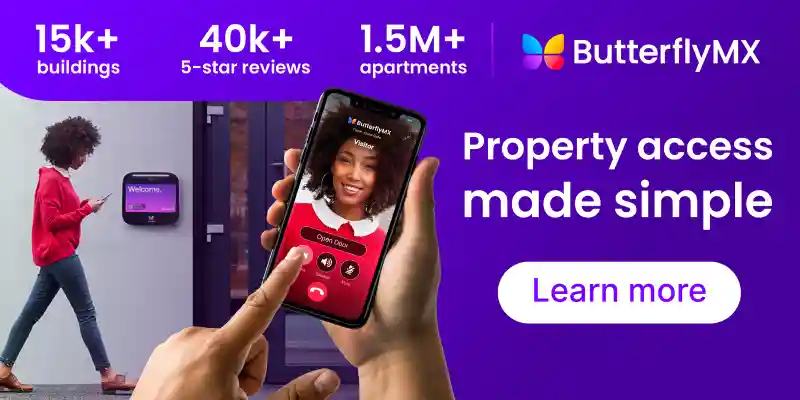Key takeaways
- Effective access control in Milwaukee protects property, visitors, and occupants while streamlining operations.
- There are multiple types of systems, and choosing the right mix matters.
- A Milwaukee access system should offer scalability, remote management, audit logs, visitor workflows, and integration with your building tech.
- When hiring an installer in Milwaukee, vet for local experience, understanding of building codes, integration ability, and service model.

In today’s fast-paced commercial real estate environment, access control systems have become a critical element in ensuring both the safety and efficiency of your property. In Milwaukee, Wisconsin, where the blend of modern and historic buildings creates unique challenges, a reliable, scalable commercial access control system enhances security and streamlines building operations.
Whether you manage a multi‑tenant office building, a retail complex, or a mixed‑use property, understanding the importance of commercial access systems in Milwaukee will help you make informed decisions that contribute to the long‑term success of your business.
From managing day‑to‑day access to providing a seamless user experience, the right system can significantly impact your building’s performance and your tenants’ satisfaction. In this guide, we’ll explore why access control matters in Milwaukee, the types of systems available, and how to choose the best solution for your property.
Navigate this post:
- Why access control matters in Milwaukee
- Types of access control systems and technologies
- What a Milwaukee access control system should offer
- ButterflyMX: The most robust commercial Access Control System
- Commercial Access Systems in Milwaukee FAQs
Why access control matters in Milwaukee
In the Milwaukee, WI market, commercial buildings face more than just unlocking doors. For property managers, building owners, and developers, access control is a foundational piece of both security and occupant experience.
Milwaukee’s weather, mixed‐use developments, older building stock, and evolving tenant expectations all increase the stakes.
A robust access system helps you:
- Prevent unauthorized entry and reduce the risk of theft, vandalism, or liability.
- Manage deliveries, guests, vendors, and employees with fewer bottlenecks and more visibility.
- Provide a modern experience: tenants expect smartphone access or app control, not just fobs.
- Future‑proof your property with retrofits and conversions.
- Support operations for tenants, shift workers, and remote management needs.
Types of access control systems and technologies
When evaluating commercial access systems in Milwaukee, you’ll encounter a variety of technologies, each tailored to different security needs and operational requirements. Understanding these different systems and their key features can help you determine which solution is best suited for your property.
Here’s an overview of the main types of access control systems available:
1. Key cards and key fobs
Key cards and key fobs are among the most common and established forms of access control. These physical credentials are swiped or tapped at a reader to grant access to specific areas within a building. While these systems are widely used and affordable, they can come with some challenges.
For instance, if a key card is lost or stolen, it needs to be quickly replaced to maintain security. Additionally, managing a large number of physical credentials can become administratively burdensome over time. However, they remain a solid choice for smaller buildings or properties with a limited budget. They are especially effective for interior doors or areas with less frequent access.
2. Keypads
Keypad or PIN-based access systems require users to enter a unique code to gain entry. These systems do not rely on physical cards or fobs, reducing the need to manage physical credentials. This can make access control simpler in some situations.
However, managing multiple codes, especially in buildings with high personnel or tenant turnover, can become cumbersome. Codes need to be updated regularly to maintain security, and if a code is compromised, it must be revoked immediately. Keypads are ideal for situations where budget is a concern or for smaller buildings with fewer access points.
3. Mobile access
Mobile access systems that use smartphones, Bluetooth, or NFC (Near Field Communication) are becoming increasingly popular in newer commercial buildings. These systems allow users to unlock doors or gates using their smartphones, offering a convenient and secure alternative to traditional key cards or fobs.
Mobile access is particularly appealing because it reduces the risk of lost or stolen credentials. Users can simply tap their phone or use an app to gain entry. While this technology is highly secure and convenient, it does require a robust IT infrastructure and app support. Additionally, it relies on users having smartphones compatible with the system. Despite these considerations, mobile access is ideal for properties that want to provide tenants with a cutting-edge, user-friendly experience while also streamlining access management.
4. Video intercoms
Video intercom systems combine audio and video to allow building managers or tenants to communicate with visitors before granting them access. These systems are particularly useful for commercial buildings with high foot traffic or secure entry points, such as lobbies, gates, or office floors. Video intercoms offer an added layer of security by allowing security personnel or tenants to visually verify visitors’ identities before granting access. This not only enhances building security but also improves the visitor experience.
However, they can be more expensive than traditional access control systems and may require a reliable internet connection for optimal performance. Some buildings may also face privacy concerns, particularly if video footage is recorded. Despite this, video intercoms are a great choice for multi-tenant buildings or properties where high levels of security and communication with visitors are important.
5. Cloud-based access control
Cloud-based access control systems are among the most advanced solutions available today. Unlike traditional systems that rely on on-site servers or dedicated hardware, cloud-based systems store data and manage access remotely. This provides a number of advantages, such as the ability to manage access from anywhere, at any time, and the scalability to accommodate properties of any size.
With a cloud-based system, building managers in Milwaukee can remotely change permissions, monitor access logs, issue visitor passes, and manage multiple doors or buildings through a single dashboard. These systems are also generally more cost-effective in the long term, as they eliminate the need for on-site hardware and manual updates. However, they do require a stable internet connection, and there may be concerns around data security in some cases.
What a Milwaukee commercial access control system should offer
A Milwaukee access control system should provide a seamless blend of security, convenience, and flexibility to meet the needs of both property managers and tenants. Whether you’re managing a multi-tenant office building or a retail complex, your system should offer remote management, scalability, and integration with other building technologies.
Here are some features your access control system should offer:
- Remote administration and scalability. The system should allow you to add or revoke access credentials, manage permissions, monitor logs, and adjust settings from a web or mobile app. Buildings in Milwaukee may have different tenants, floors, amenities, and access needs.
- Unified platform for all entry points. Rather than managing separate systems for lobby doors, parking gates, elevators, and amenities, the ideal platform integrates them. One vendor, one dashboard, one credential ecosystem.
- Visitor management and temporary credentials. Your system should allow you to issue temporary access for vendors, guests, or delivery drivers. This helps avoid security gaps and improve the guest experience.
- Audit logs. You want time‑ and date‑stamped logs of access events, ideally with photo or video capture. These help with investigations, audit trails, and regulatory expectations.
- Integration with building systems. Your access control should play nicely with property management software, elevators, HVAC systems, and other smart building systems.
- Retrofit‑friendly installation and support. Milwaukee buildings often have older wiring or infrastructure. Choose a solution that can be retrofitted, minimizes downtime, requires minimal wiring changes, and has local installer support.
- User experience and tenant satisfaction. Don’t overlook usability. Tenants and visitors should find the experience intuitive. A better experience helps tenant retention and builds a reputation.
ButterflyMX: The most robust commercial Access Control System
ButterflyMX offers a comprehensive commercial access control solution that aligns well with the needs of Milwaukee commercial properties.
Here’s why it stands out:
- Modern cloud‑based platform
- Multiple credential support and mobile access
- Video Intercom and audit trail
- Minimal wiring and retrofit-friendly
- Integration with property management systems
- Scalability for commercial properties
Modern cloud‑based platform
ButterflyMX lets you manage every door, gate, and garage from one cloud‑based dashboard and smartphone app. You can add or remove users, view access logs, issue visitor passes, and handle permissions remotely.
Multiple credential support and mobile access
Users can open doors and gates with a smartphone, a key card, a PIN, or a fob. Visitor Passes via QR or PIN are also supported. This flexibility is ideal in commercial buildings with diverse user types.
Video Intercom and audit trail
ButterflyMX Video Intercoms allow users to see and speak with visitors before granting access. It records photo and video logs of access events for audit and security.
Minimal wiring and retrofit-friendly
The system is designed to be installed over existing wiring with minimal conduit. The hardware often requires just internet, power, and door lock wiring. For Milwaukee’s older buildings, this is a major benefit.
Integration with property management systems
ButterflyMX integrates with PM platforms, automating credential management when tenants move in or out. This helps your building operations run more smoothly.
Scalability for commercial properties
Whether you manage a single‑tenant office, a mixed‑use development, or a portfolio of buildings in Milwaukee, ButterflyMX supports property‑wide access across doors, gates, elevators, garages, and amenity spaces.
Commercial Access Systems in Milwaukee FAQs
- What does a commercial access control system cost in Milwaukee?
- Do I need a separate system for gate/garage access?
What does a commercial access control system cost in Milwaukee?
Costs vary significantly by size of building, number of doors, wiring needs, credentials, and whether you’re retrofitting. According to general guides, access systems may range from a few thousand dollars per door to much more when integration, wiring, or enterprise features are required.
Do I need a separate system for gate/garage access?
Not necessarily. A modern platform should support parking gates and garage entry, as well as doors and elevators. If you choose a vendor that supports vehicle readers, tag readers, or mobile access, you can unify everything. For example, ButterflyMX supports gates, garages, and elevators on a single platform.

Get your free quote!
Fill in the form below, and we'll email you right back.
Want a free quote?
Fill in the form below, and we'll email you right back.
You’ll be redirected shortly...






